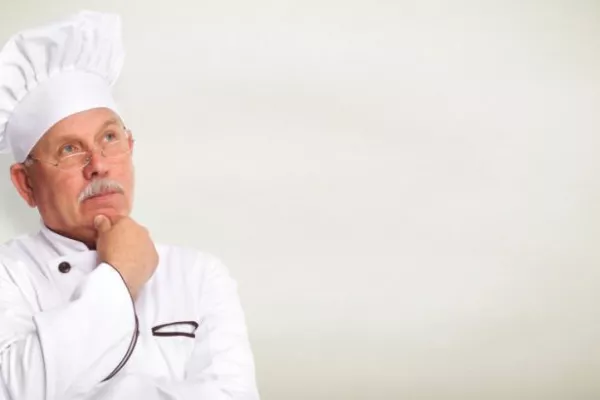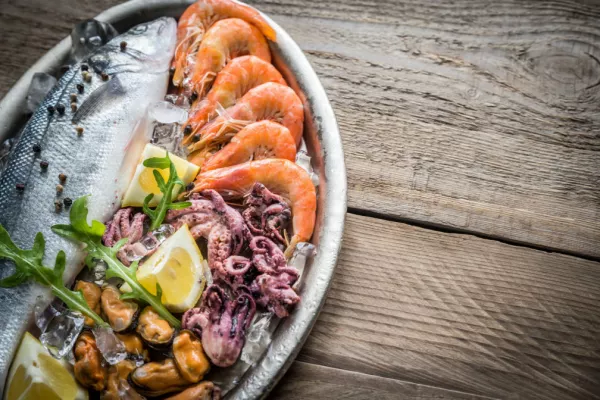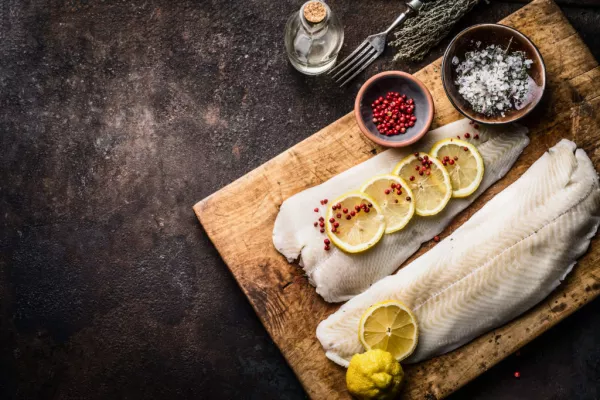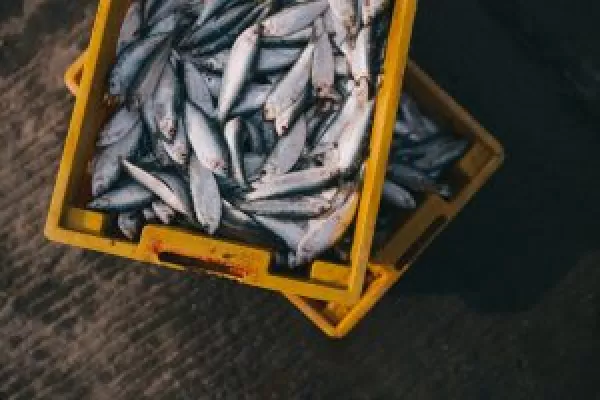Chef Telepan wants to make porgy happen.
Porgy swim along the US coast in large numbers, blissfully unknown to many American diners, while shrimp, tuna and salmon, often from thousands of miles away, remain the big kahunas. But as chefs, who long ago made farm-to-table food ubiquitous, set their sights on the oceans, the lowly porgy is getting some time in the sun.
At Oceana, Bill Telepan recently added it to his menu, replacing a farmed dorade. At $38, it is the least expensive seafood-based second course of the four-and-a-half-star Midtown Manhattan restaurant’s dinner offerings. For a fish once considered mere by-catch, caught inadvertently by fishermen hunting for more valuable species, it’s still quite a feat.
Porgyisn’t the only change at Oceana since Telepan, whose eponymous, Michelin-starred restaurant was a farm-to-table pioneer, came aboard last fall. In June, he committed the restaurant to Smart Catch, a new sustainable-seafood effort led by the James Beard Foundation, which aims to get restaurants to serve better seafood choices. The idea is to take the very complicated question, “Is this seafood sustainable,” and answer it for consumers with a logo. If the restaurant is a Smart Catch participant, diners can enjoy their seafood—whether salmon, oysters, or porgy, farmed, wild, fresh or frozen—at ease.
“What I’m trying to do,” Telepan said, “is take this ship and turn it in a sustainable direction.”
The Smart Catch program is well-timed, with growing consumer interest in both eating seafood at restaurants and learning more about the provenance of their food. Orders for clam and lobster at independent, full-service restaurants, as well as salmon servings in the “casual independent” category, all increased by double digits in the year that ended in March from the year before, according to the NPD Group, even as at-home dining on seafood stayed flat.
But seafood presents its own minefield when it comes to sustainability. Unlike with land-based proteins, there is no U.S. Department of Agriculture “organic” seal for seafood. Terms such as “farmed” and “wild” don’t necessarily indicate whether something is responsibly raised or caught. Wild seafood can contribute to overfishing. Aquaculture can involve crowded pens, escapes of farmed fish into the wild and the overuse of antibiotics. Still, both can be done with minimal environmental impacts. Meanwhile, in what seafood journalist Paul Greenberg has dubbed “The Great Fish Swap,” more than 91 percent of seafood eaten by Americans comes from overseas, while a third of what gets caught domestically gets exported.
Consumers may be overestimating their knowledge of this complicated topic: Some 57 percent think they are somewhat or very knowledgeable about the origin of their seafood, according to a forthcoming Keynote Report on Seafood from Datassential, even though only 16 percent have ever checked seafood purchasing guidelines such as those from the Monterey Bay Aquarium’s Seafood Watch.
“Getting Americans to not eat shrimp is like saying, you know what—that TV—how about we read a book instead?”
For restaurants, signaling seafood sustainability is still a rarity. Only 1.1 percent of restaurant seafood menus have the word or a derivative of it on their menus today, according to Datassential, and that’s nearly three times what it was in 2013. Other language is more popular. “Wild” appears on 9.3 percent of seafood menus. “Local” is mentioned on 4.6 percent, up a third since 2013.
Smart Catch, which launched nationally under the James Beard banner in June after a 2015 pilot in Seattle, is a chef-friendly marketing tool to help diners bypass the confusing terminology with a simple logo. Chefs can sign up for a menu-assessment and education program, Katherine Miller, the Beard Foundation’s senior policy director, said. The program now counts 292 restaurants in its ranks. It relies on information collected by the nongovernmental organization FishChoice to measure the sustainability of seafood, using ratings from Seafood Watch—green for “best choice,” yellow for “good alternatives” and red for “avoid”—or, if that’s unavailable for a given fishery, from the National Oceanic and Atmospheric Administration.
A chef enters his or her planned order, including the kinds of seafood, quantities and sources, and FishChoice provides a score. If part of an order is rated low, FishChoice usually offers better alternatives so the chef can make the necessary adjustments. To become a Smart Catch “leader,” a restaurant must score an 80 percent or higher. This is all done out of the customer’s sight, though anyone can look up a Seafood Watch rating for a particular piece of fish.
“Seafood can be very confusing,” Miller said. “What if one species from one fishery is a green but the same species from another fishery might be a yellow or a red?”
If chefs serve more green options, the thinking goes, consumers will purchase more green options, whether they mean to or not. But even the program’s cheerleaders at Beard don’t pretend they’ve got a perfect system. The FishChoice tool was developed largely for major seafood buyers such as Compass Group and Disney Parks and Resorts, not Chef Telepan. “What is being missed is the importance of the local sources that big buyers can’t work with,” said Corey Peet, the Smart Catch sustainability adviser. “The rankings are missing those pieces.”
That’s one reason a restaurant needs only an 80 percent on its test, he said—so that a choice like Telepan’s porgy, which comes from an unrated fishery that nearly any seafood expert will tell you should be fished, can still be served.
For a restaurant such as Oceana, which serves a variety of seafood options totaling about 1,000 pounds a week, the complications can be worth the effort. Those with a much narrower seafood menu can take a simpler approach. Chopt, an East Coast salad chain with more than 40 locations, recently announced a new partnership with Sea to Table, which sells traceable, U.S.-caught, wild seafood, to source its shrimp.
“We do it for the flavor,” Chopt co-founder Colin McCabe said. “We know there’s a direct correlation between the flavor and the sustainability and transparency.”
Chopt was so unhappy with the shrimp from its previous supplier, a sustainably certified farm in Asia, that it was "on the edge of killing the ingredient," McCabe said. He found that Sea to Table, whose shrimp tasted better, was more traceable and was even cost-neutral because of its higher yield after cooking. The chain is now buying about 10,000 pounds of Sea to Table shrimp each month.
Wild seafood isn’t necessarily a better choice than farmed, but Sea to Table founder Sean Dimin develops close relationships with his fishermen to make sure they’re using the industry’s best practices. For the Gulf shrimp sold at Chopt, as well as in other restaurants, dining halls and directly to consumers through the company’s website, Dimin makes sure boats use the legally required “turtle excluder devices,” which keep sea turtles from getting stuck in nets, as well as by-catch reduction devices, which cut the amount of unintended captures for a shrimper.
“That produces a pretty clean fishery right there,” Dimin said.
Both Smart Catch and Sea to Table could increase the amount of sustainably caught or harvested seafood consumers eat. The question is whether their efforts, when combined with those of consumer brands and retailers, will raise consumer awareness of sustainable seafood enough to create the kind of demand that took farm-to-table into the mainstream.
With Smart Catch, consumers would have to care enough to seek out, or just notice, the logo, and then go farther by asking the staff what makes any particular piece of seafood “sustainable.” At that point, the staff needs to have the information to answer them. That’s a tall order, especially in a busy restaurant.
OVERFISHING
At a recent lunch at Oceana, a patron asked the waiter what kind of fish was in the fish and chips and was told it was hake. It was actually local spiny dogfish, an abundant species, rated yellow by the Monterey Bay Aquarium, that suffers from an unfortunate name. It’s also high in mercury if fished in certain waters, such as those off Australia or Crete, while those fished in the Northwest Atlantic, where Chef Telepan’s originate, have lower levels than do such commonly consumed species as albacore tuna or mackerel. A concerned diner would require a knowledgeable server.
“Some of the waiters can answer questions, but not all,” Telepan said.
The porgy is going well, he said. “We got complaints from customers about the bones”—porgies are famous for them—“but we found a new way to butcher it before we cook it,” which solved the problem.
Current menus and marketing materials at Chopt don’t mention Sea to Table, and asking a salad assembler for information requires shouting over the heads of other patrons putting in their orders. Not exactly an ideal learning environment, but the chain says it will be adding Sea to Table’s name to items soon. At that point, the onus again returns to the customer to find out what makes the ingredient exceptional, if sea-to-table is ever to approach the popularity of farm-to-table. Plus, while Smart Catch participants are incorporating lesser-known species, broadening customers’ seafood horizons, Chopt is still playing it safe, serving Americans’ favorite seafood.
Experts see both campaigns as steps in the right direction.
“The consumer public has only recently engaged in sustainable seafood to the point where it can be a return on investment,” said Barton Seaver, an author and chef and the director of the Sustainable Seafood and Health Initiative at the Harvard T.H. Chan School of Public Health. “And that makes a big difference, because what do restaurants do? They sell.” Smart Catch, he said, “creates an atmosphere of trust.” If consumers want sustainable seafood, giving them an easy way to find it is a good thing, even if educating them is a bigger challenge.
“We know there’s a direct correlation between the flavour and the sustainability and transparency.”
“There are a lot of emblems and certifications” already out there, said TJ Tate, director of the Sustainable Seafood Program at the National Aquarium in Baltimore, and “the jury’s still out” for her on Smart Catch, since the first iteration of the program (not connected to the Beard Foundation) didn’t get very far. “But James Beard has the integrity and platform that they’re not going to put things out without high quality,” she said, which makes her hopeful that such kinks as uneducated servers will get worked out.
Both Seaver and Tate are ebullient about Sea to Table, even if the partnership with Chopt indulges the American shrimp obsession that led to the disreputable farming practices common in Asia.
“Getting Americans to not eat shrimp is like saying, you know what—that TV—how about we read a book instead?” Seaver said.
Tate hopes Chopt will eventually expand its seafood offerings into less charted waters, noting that Sea to Table would be a good partner, since it sells a number of underused species such as Gulf of Maine redfish and Chef Telepan’s favorite, Atlantic spiny dogfish.
“We don’t have any plans for by-catch now,” McCabe said. He occasionally runs specials to gauge consumer interest in new ingredients, but the two examples the restaurant gave were both of another American standby: salmon.








